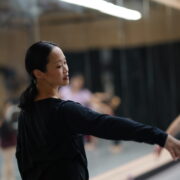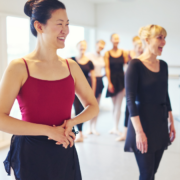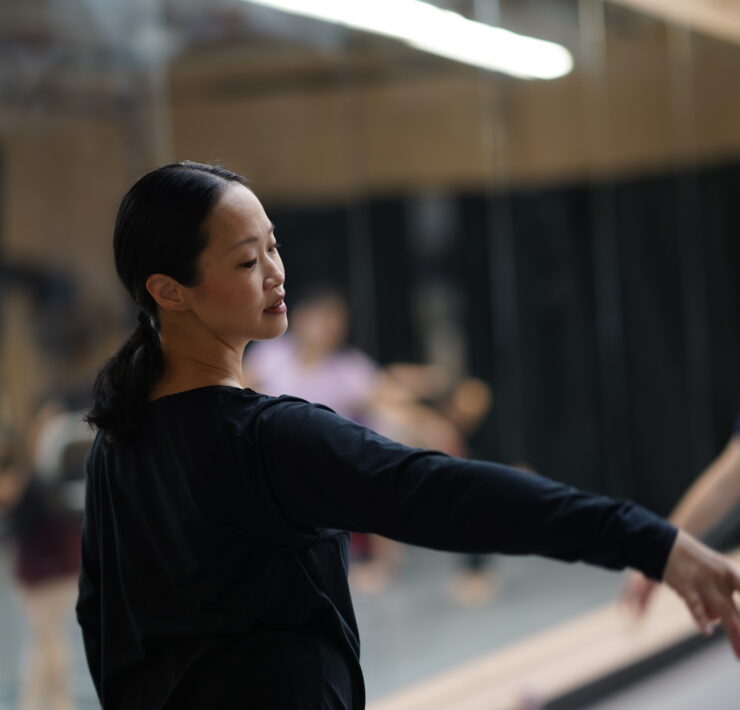Happily Dancing to Heal the Brain

Dawn, the co-founder of Verima, a wellness sanctuary, and a…



 +1
+1Autoimmune Encephalitis (AE) is a bewildering condition where the immune system turns against the brain, causing inflammation and a spectrum of neurological challenges. This disorder can drastically alter lives, plunging individuals and their loved ones into a relentless quest for stability and healing. My son’s battle with AE thrust our family into this turbulent journey, a path fraught with uncertainty, fear, and an unyielding search for relief. Amidst this chaos, we discovered a beacon of hope in an unexpected form: dance. As a lifelong dancer and instructor, I’ve always embraced the power of dance, but it was through my son’s struggle that I truly grasped its therapeutic potential.
Dance, in its essence, offered us more than just physical exercise; it became our happily dancing sanctuary, a therapeutic tool that bridged the gap between despair and healing. Through the rhythmic movements and the expressive freedom of dance, we found a way to combat the effects of AE, fostering a sense of joy, resilience, and recovery. This narrative isn’t just about confronting a daunting medical condition; it’s a testament to the journey of rediscovering hope and strength on the dance floor. Herein lies our story, an exploration of the intricate dance between the immune system and neurological well-being, and how embracing the art of dance can illuminate the path to recovery.
Understanding Autoimmune Encephalitis
The diagnosis of AE presents a significant challenge. Its symptoms can mirror those of other neurological disorders, making it a complex puzzle for medical professionals. The journey to a correct diagnosis is often long and fraught with uncertainty, involving a series of tests including MRI scans, spinal fluid analysis, and EEGs to monitor brain activity.
Autoimmune Encephalitis is a condition where the immune system, which usually guards against invaders like viruses and bacteria, mistakenly targets the brain. This misdirected attack leads to inflammation of the brain, manifesting in a variety of symptoms such as memory loss, seizures, confusion, behavioral changes, and in severe cases, loss of consciousness.
Treatment options for AE typically focus on two main objectives: calming the immune response with immunotherapy treatments such as steroids, intravenous immunoglobulin (IVIG), or plasmapheresis, and managing symptoms through medications and rehabilitation therapies. However, the path to recovery varies greatly among individuals, requiring a tailored approach that considers the unique aspects of each case.
In the case of my son, the trigger for his AE was particularly perplexing. He had been battling back-to-back infections including streptococcus, Mycoplasma, and COVID-19 upon returning to school mask-free. It’s believed that in some cases, infections can act as a trigger for AE, kickstarting the immune system into overdrive and leading to the brain being mistakenly targeted. This connection between infections and AE added another layer of complexity to understanding and managing his condition.
Incorporating Dance into Recovery
Incorporating dance into my son’s recovery routine marked a pivotal turn in our journey through the shadowy realms of Autoimmune Encephalitis (AE). This integration of rhythmic movements and music into his daily life was not merely an addition to his rehabilitation program; it became a lifeline, rekindling his spirit and enhancing his recovery in ways that traditional therapies had not fully addressed. For those looking to explore additional wellness strategies tailored specifically for women, including biohacking tips designed to enhance overall wellness, you might find this guide on female wellness particularly useful. These insights can complement the benefits of dance and other therapeutic practices.

Our initial foray into dance as a therapeutic tool began with simple movements set to his favorite tunes. These moments, though modest, were profound. I witnessed a visible uplift in his mood with each session, a spark of joy in his eyes that had been dimmed by the relentless battle with AE. It was as if the music and movements reached into a part of him that had been locked away, reminding him of the joy and freedom that life could still offer.
Encouraged by these early signs of positive impact, we ventured into more structured dance classes, starting with a local community drop-in hip-hop class that we attended together on Sunday mornings. This experience was transformative for him. The infectious energy of the music, coupled with the challenge of mastering new dance moves, provided a multifaceted stimulus for his brain. It was not just about moving to the beat; it was about memory, coordination, and, crucially, engaging multiple areas of his brain simultaneously. This, I learned, is a unique aspect of dance that sets it apart from other forms of exercise; it truly is a form of cognitive multitasking that can enhance brain function in a holistic manner. For those looking to explore additional wellness strategies tailored specifically for women, biohacking tips designed for female wellness offer valuable insights and actionable advice that can complement the benefits of dance and other therapeutic practices.
Beyond the cognitive and mood benefits, dance opened a new avenue for social interaction and reintegration into the community. The isolation my son felt due to his condition had been palpable, but through dance, he found a new sense of belonging. The dance class became a safe space where he was just another participant, not defined by his illness or the challenges it brought. This reconnection with peers outside the clinical and educational environments where he had become the “sick kid” was invaluable. It allowed him to rebuild his social identity and confidence, stepping out of the shadow of his condition.
The importance of this social aspect cannot be overstated. Being part of a group, sharing laughs, and even the occasional embarrassment of a misstep, contributed significantly to his emotional wellbeing. It underscored the role of community and belonging in the healing process, offering a counterbalance to the isolation and stigma that can accompany chronic illnesses like AE.
In reflecting on this journey, the integration of dance into my son’s recovery has been a revelation. It has shown us that healing is not just about treating symptoms but nurturing the spirit. Dance, with its unique blend of physical activity, cognitive engagement, and social interaction, has been a key component of his path toward recovery, offering lessons in resilience, joy, and the enduring power of human connection.
Dance Therapy: Beyond Physical Healing
Dance therapy, as recognized by the American Dance Therapy Association (ADTA), transcends traditional boundaries of dance, embracing it as a powerful psychotherapeutic tool that promotes holistic healing. This form of therapy leverages the natural, expressive movement of dance to support individuals in achieving emotional, social, cognitive, and physical integration.
A key component of dance therapy that supports its therapeutic efficacy is Rhythmic Auditory Stimulation (RAS). RAS involves moving to a set rhythm or beat, a technique that has shown remarkable benefits for motor function, particularly in individuals with movement disorders. For those recovering from neurological conditions, RAS can significantly improve gait, balance, and the coordination of movements. This auditory-motor synchronization helps in retraining the brain, facilitating smoother, more coordinated motor responses.
Incorporating RAS into dance therapy not only aids in physical rehabilitation but also enhances the emotional and cognitive benefits of therapy. The predictability and structure of the rhythm provide a comforting framework within which individuals can explore movement, supporting both structured rehabilitation goals and the expressive, creative aspects of dance therapy.
Conclusion
Dance, in its essence, has served as more than just a form of physical exercise; it has been a vital therapeutic tool, facilitating emotional release, cognitive enhancement, and social reconnection. This experience has reinforced the belief that healing extends beyond conventional medicine, tapping into the expressive, communal, and restorative power of movement.
It serves as a potent reminder of the therapeutic potential inherent in dance and movement therapy—a reminder that such practices can be integral components of recovery for those facing neurological challenges. The integration of rhythmic auditory stimulation (RAS) within dance therapy, in particular, highlights the capacity of structured movement and music to support motor function and cognitive recovery, offering a holistic approach to healing.
This exploration into the healing power of dance underscores a broader truth: whether it’s dance, art, sports, or yoga, there exist numerous therapeutic modalities that engage the body, enrich the mind, and uplift the soul. At Breathe, our mission is to illuminate these pathways to wellness, showcasing the diverse ways in which movement and creativity can nurture recovery and enhance well-being.
Each month, we delve into the vibrant tapestry of dance and community throughout the Bay Area, seeking out new experiences that promise not only to engage but also to heal. Our team is dedicated to vetting these experiences, ensuring they align with our mission to support community connection, holistic health and recovery. We invite you to join us on this journey, to explore the myriad ways in which movement can be a source of strength, resilience, and joy.
Dawn, the co-founder of Verima, a wellness sanctuary, and a devoted mother of three, embodies the essence of passion and perseverance. Residing in Palo Alto, she seamlessly blends her roles as an entrepreneur, ballet teacher, and health advocate, particularly for PANS, driven by her son's condition. With a life dedicated to wellness, family, and community involvement, including volunteering at local schools and savoring the arts, Dawn is a testament to the power of a purpose-driven existence. Her journey illustrates the formidable force of a mother on a mission, inspiring through her advocacy and commitment to creating a healthier world. Follow her insights and adventures @Verimadawn, where she shares her passion for wellness and the balance of business and motherhood.











